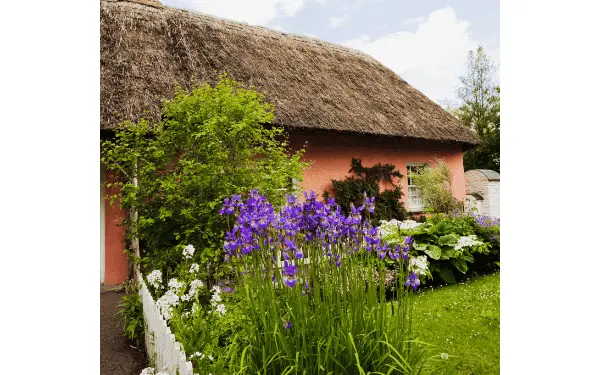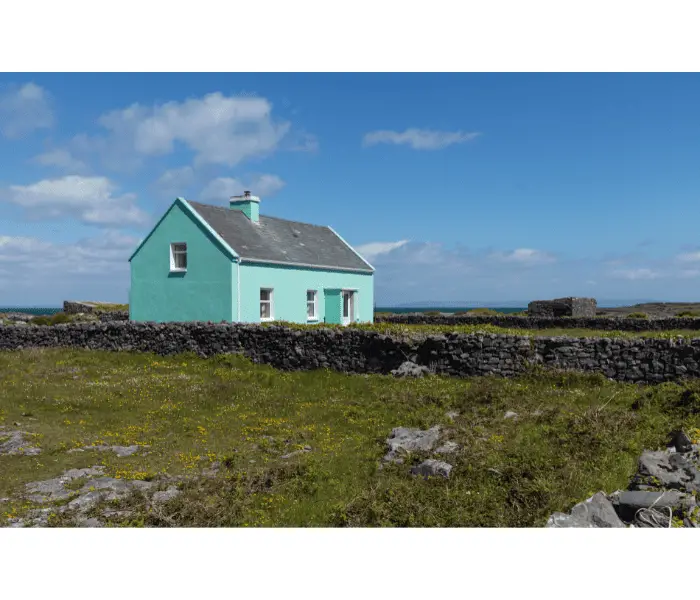Cottages often follow fairly set (but unwritten) guidelines in terms of style. In some areas of the UK, english cottage communities can have rules about what colors building exteriors can be painted and how their gardens can be arranged.
So, if you’re looking to renovate or decorate a cottage, you might be asking, what is the best color to paint a cottage? The short answer is white for the walls if they’re rendered. If not, don’t decorate over the bare stone because it can look much nicer. For doors and window frames, go with whatever color you think most suits your cottage’s vibes.
Below, we’ll cover some of the best colors for cottages and some suggestions for how to make them work together.

What are Cottage Style Colors?
Cottage colors overlap, to an extent, with farmhouse colors and styles. As such, cottage style mostly focuses on natural colors and neutrals, such as:
· White
· Beige
· Browns
· Greens
· Grays
· Blues
In the old days, cottages would be painted whatever colors were readily available. If you go back far enough into the past, people would have mixed their own paints from ingredients they could gather from the land.
This is why neutrals play such a big part. Earth could give you browns and yellows while plants could give you greens.
Neutral tones would come from wood and stone. You wouldn’t find much blue, red or purple, as these were expensive colors to make.

Of course, this isn’t the case anymore, but tradition has persisted in terms of what we associate with the cottage style. While you have more freedom with modern paints, there are still some general rules to follow.

What are Country Cottage Colors?
Many of the colors listed above are found inside a cottage, but you could use all of them for a cottage’s exterior. The most common color for the actual walls is white, though.
In the past, this was because whitewash (or limewash) was the cheapest and easiest color to produce. You can read more about it here.
However, you can easily pair whitewash with literally any color – it’s one of the beauties of white! Let’s look at some of the best colors to use for a cottage exterior.
5 Colors to Paint a Cottage
You could use any of these colors inside a cottage, too, but we’re focusing on the outside in this article. This is mainly because you can do what you want inside your home, but these colors will help you to achieve that chocolate box appearance so many people desire.
1. Sage Green
Sage green is a favorable color for cottage exteriors. It’s similar enough to the surrounding plant life that it’s not jarring, but the hint of gray separates it just enough.
Sage is a lovely bright color that’ll look great all year round, regardless of the weather.
Better yet, it’s suitable for windowsills and doors on both whitewashed and unrendered cottages. The gray and green tones pair well with both white and stone, giving you loads of flexibility.
2. Sky Blue
Sky blue is another great color for cottage exteriors. It follows a lot of the same logic as sage, but it contrasts well against the surrounding foliage.
Many see blue as a colder color than green, and this can make it work well with a whitewashed building.
The main benefit of sky blue is that it’s much softer than something like ultramarine. It’ll arguably work better on a whitewashed building than an unrendered one, although nothing is stopping you from using it on either.
3. Yellow
Yellow isn’t a traditional exterior color for cottages, but you’d see it a lot in interior paints. This is especially the case where soil is rich in ochre, as that was the most common pigment for yellow paint.
Unsurprisingly, there are plenty of directions you could take yellow accent paint.
Perhaps the best would be something like sunflower yellow, as it carries a lot of strength and boldness that would work well against both whitewash and stone.
However, if you wanted to keep things soft, a light yellow would also work well. You’ll want to think about how it works next to your cottage garden in the summer, too. For extra pop, consider prioritizing bright pink flowers in your garden!
4. Lilac
You can probably spot a theme around the most suitable colors for cottages. Lilac is a soft purple that still has a lot of pop compared to other pastels. It carries hints of spring and will contrast well against foliage and whitewash.
Make sure you use it sparingly, though, as too much will overwhelm other colors. It’ll be fine for window frames and doors, but leave it at that because it’ll draw too much attention otherwise.
5. Brown
Brown isn’t the most exciting color in the world. That said, it’s a pretty traditional option for exterior woodwork. Staining wood is as much a viable option as painting it, and it typically results in dark brown colors.
Of course, this doesn’t mean you’re limited to wood stains. After all, the chances are high that you’ll be painting over already painted woodwork, meaning you couldn’t stain it anyway!
Aim for chocolate brown or similar – something with a deep, warm, earthy hue. It’ll work well against whitewash and stone, and will complement any trees and foliage in your garden.
Final Thoughts
Decorating a cottage doesn’t require you to stick with conventional rules. However, doing so is the easiest way to achieve that picture-perfect look.
While there aren’t many explicit guides on what colors you should use around a cottage, many unwritten rules relate to their historic design.
Hopefully, the list above will give you some inspiration about the best cottage style colors.
Whatever you choose, use it appropriately to make existing colors pop and to keep that traditional feel to your home.



